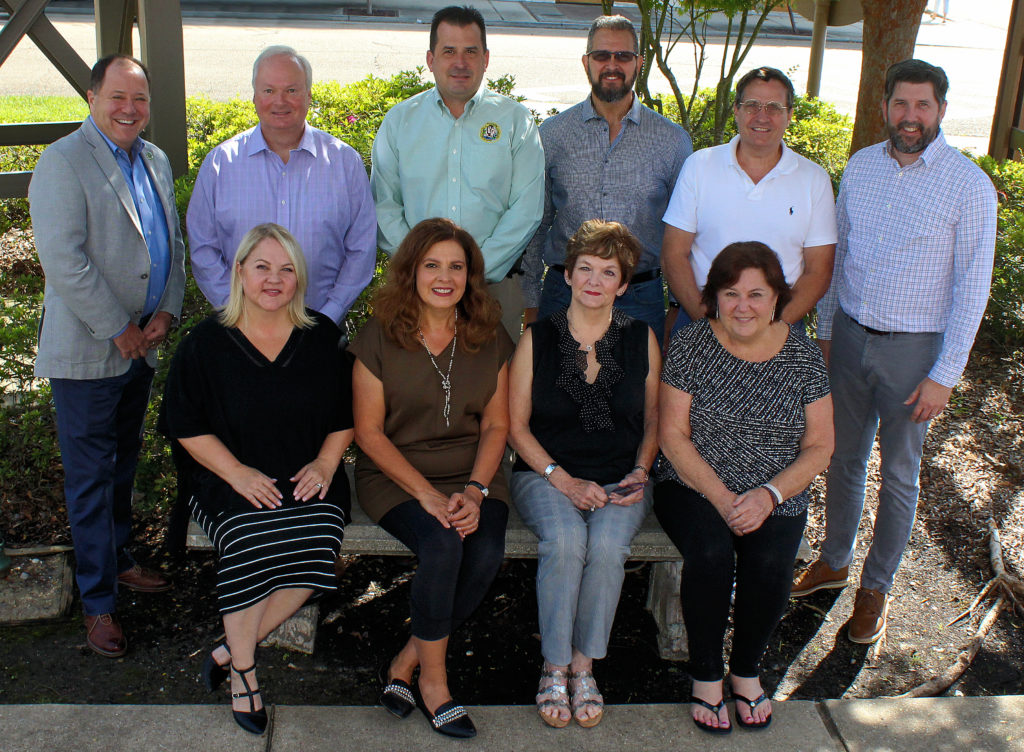The mission of the Foundation is to preserve the city’s culture, character and community.
2022 Board Members
Officers:
- Ex Officio – Mayor Mark R. Johnson
- President – Mark W. Verret
- Vice President – Debbie McDougall
- Treasurer – Lester Richoux
- Recording Secretary – Patrick Fulton
Board Members:
- Jose Balii
- Debra McDougall
- Gary Blocker
- Celeste Oelking
- Paula Shows
Consulting Historian:
- Howard Nichols
Seated, left to right, Sarada Bonnett, Paula Shows, Celeste Oelking, and Vice President Debbie McDougall. Standing from left Ex Officio – Mayor Mark R. Johnson, President Mark W. Verret, Gary Blocker, Jose Balii, Recording Secretary Patrick Fulton, and Treasurer Lester Richoux.
A message from the President-
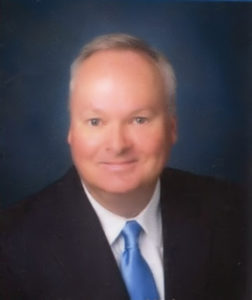
Back in 1813, when John Wharton Collins founded the City of Covington as the Town of Wharton, he laid the town out in its unique pattern of squares within squares that were accessed by alleyways. He named the town center the Division of St. John which is now known as our historic district. This “new” city was formally incorporated in 1816 by the state legislature and after all of the founder’s efforts, they renamed the city, Covington. Not only did the state legislature rename the city, but there are also conflicting stories about how the city actually came to be named Covington.
One theory is that our city was named in honor of General Leonard Covington, a hero of the War of 1812. There is, however, an interesting theory that the
city was actually named in honor of the bluegrass whiskey made in Covington, Kentucky which was apparently enjoyed by the local officials. Regardless of which story you tend to believe, there is no question that the City of Covington has thrived in its over 200 years of distinction. And, out of that bicentennial celebration in 2013, the CHF was established in an effort to preserve the city’s culture, character, and community.
Covington has been blessed with a tremendous amount of resources starting first with its resilient residents. With the ever-increasing amount of growth, it is imperative to have a clear vision towards the future while preserving the very rich cultural and historical past. As we preserve our beloved culture and history, we continue to provide opportunities for learning, reflecting, and celebrating the charm and character of our city. Today, our mission is to continue the celebration of the culture, character, and community of Covington.
This year, I am pleased to announce an inaugural signature event, Farm to Table. It will be a memorable night as we enjoy the exploration of a true locally resourced dinner with interesting libations on April 3. The Covington Antiques and Uniques Festival will take place on April 23 and 24th, and we encourage everyone to come out and support our vendors along with the Covington Heritage Foundation. On May 30, we will celebrate our Veterans with a Memorial Day celebration at Bogue Falaya Hall. Please join us as we celebrate, honor, and remember. We will have our Characters of Covington event in the summer, followed by a renewal of our Whisperings event, a Covington Cemetery living history tour on October 30. And, of course, we will have our History and Holly home tour on December 4, 2022. We have much to be thankful for, and I look forward to seeing you at our upcoming events.
History of Covington
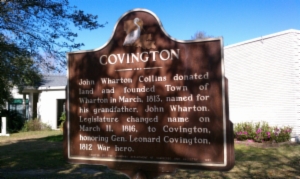 John Wharton Collins, a New Orleans merchant by way of New York, founded the City of Covington in 1813 as the Town of Wharton. John Collins’ father, Thomas Wharton, fled to Philadelphia from Scotland after the Seven Years War in 1763 and assumed his mother’s maiden name, Collins, in order to maintain anonymity in the colonies. (As a Scottish militiaman, Thomas found himself on the winning end a dual to defend his sister’s virtue.) Once in the colonies, Thomas was found to be a Tory sympathizer and was imprisoned during the Revolutionary War. His wife Mary successfully gained his freedom upon appeal to George Washington. Thomas was released, and the family moved to Nova Scotia where Thomas died in 1790, leaving Mary a widow with seven children. A resourceful woman, Mary made her way to New York where she reared her children. Her son William became a postal boat captain and was the first of the family to move to New Orleans. John later followed in 1800 and opened a mercantile store on Magazine Street.
John Wharton Collins, a New Orleans merchant by way of New York, founded the City of Covington in 1813 as the Town of Wharton. John Collins’ father, Thomas Wharton, fled to Philadelphia from Scotland after the Seven Years War in 1763 and assumed his mother’s maiden name, Collins, in order to maintain anonymity in the colonies. (As a Scottish militiaman, Thomas found himself on the winning end a dual to defend his sister’s virtue.) Once in the colonies, Thomas was found to be a Tory sympathizer and was imprisoned during the Revolutionary War. His wife Mary successfully gained his freedom upon appeal to George Washington. Thomas was released, and the family moved to Nova Scotia where Thomas died in 1790, leaving Mary a widow with seven children. A resourceful woman, Mary made her way to New York where she reared her children. Her son William became a postal boat captain and was the first of the family to move to New Orleans. John later followed in 1800 and opened a mercantile store on Magazine Street.
St. Tammany Parish at that time was part of a Spanish territory called West Florida. West Florida was not part of the Louisiana Purchase territory. Just two weeks prior to West Florida being ceded into the United States, the area that is now Covington was granted by the Spanish to another New Orleanian, Jacques Drieux. John Wharton Collins purchased the Drieux tract in 1813 and established the Town of Wharton on July 4. He laid the town out in its unique pattern of squares within squares (ox lots), which were accessed by alleyways, and named the town’s center the Division of St. John, now the historic district. This unique design is largely responsible for the Division of St. John’s placement on the National Register of Historic Places in 1981.
The city was formally incorporated in 1816 by the state legislature and renamed Covington, much to the chagrin of John Wharton Collins, who then returned to live out his life in New Orleans. His body was returned upon his death in 1817, and he is buried in Covington Cemetery No. 1, which faces the former City Hall at the corner of N. Columbia and Kirkland streets. There are conflicting stories about how the city came to be named Covington. One theory was that Covington was named in honor of General Leonard Covington, a hero of the War of 1812. However, local historian Judge Steve Ellis floats another theory centered around the suggestion by Jesse Jones, a local attorney, that the city be named in honor of the Blue Grass whiskey—made in Covington, Kentucky— enjoyed by town officials.
As the Parish (county) seat since 1829, Covington was the center of commerce, industry and government on the Northshore. The area’s principle industries included lumber and related pine products, brick production and agriculture. Goods were transported via the Bogue Falaya River from the Columbia St. Landing across Lake Pontchartrain to New Orleans. Tourism became popular at the turn of the century. People believed in the medicinal powers of the ozone waters of the Northshore and visited hotels in Covington to bathe and partake of “the cure,” as it had been dubbed during a yellow fever outbreak in New Orleans in 1878. In 1891, Covington was named “THE MOST HEALTHY PLACE IN THE UNITED STATES” (taken from the book St. Tammany Parish, by Frederick S. Ellis) due to the low number of deaths per population recorded in the 1890 census.
It is notable that these healthy people voted against secession in 1860. St. Tammany Parish delegates voted no to secession at the state legislature’s convention. By the time Civil War was declared, eight national flags had flown over St. Tammany Parish. The railroad arrived in 1887, and the first telephones were installed in 1884.
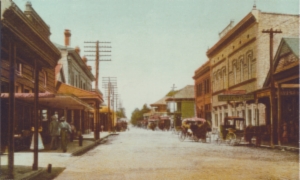 The historic Division of St. John comprises Covington’s downtown. As a result of the oil bust of 1986, much of Covington’s downtown was boarded up as recently as the early 1990s. In response to a slumping economy and decline downtown, the city applied to become a “Main Street” community and was accepted in 1987. The National Main Street Program is a downtown revitalization program, which is administered by the National Trust for Historic Preservation. It consists of a four-point approach to revitalization: 1) Organization – whereby a Main Street manager is hired who assembles a board of volunteers from the community who are stakeholders in the downtown area, to implement the program; 2) Promotion – which includes retail promotions and special events to re-establish interest and activity in the downtown; 3) Economic Restructuring – which is an organized effort to attract businesses back to the downtown with incentives and support retention of the existing businesses; and 4) Design – which oversees the restoration of buildings and maintenance of the integrity of historic downtown architecture. Covington completed the five-year program and became a graduate Main Street community in 1992. As a result of this revitalization effort, downtown Covington has experienced a resurgence of retail and professional uses.
The historic Division of St. John comprises Covington’s downtown. As a result of the oil bust of 1986, much of Covington’s downtown was boarded up as recently as the early 1990s. In response to a slumping economy and decline downtown, the city applied to become a “Main Street” community and was accepted in 1987. The National Main Street Program is a downtown revitalization program, which is administered by the National Trust for Historic Preservation. It consists of a four-point approach to revitalization: 1) Organization – whereby a Main Street manager is hired who assembles a board of volunteers from the community who are stakeholders in the downtown area, to implement the program; 2) Promotion – which includes retail promotions and special events to re-establish interest and activity in the downtown; 3) Economic Restructuring – which is an organized effort to attract businesses back to the downtown with incentives and support retention of the existing businesses; and 4) Design – which oversees the restoration of buildings and maintenance of the integrity of historic downtown architecture. Covington completed the five-year program and became a graduate Main Street community in 1992. As a result of this revitalization effort, downtown Covington has experienced a resurgence of retail and professional uses.
Covington’s present economic state: After experiencing a slow down in retail sales during the late 1990s, the City entered its second phase of revitalization. Once population growth in St. Tammany Parish reached the “critical mass” necessary to support Covington’s retailers, sales tax revenues increased accordingly. Upward trends in the local economy and migration further north have resulted in a “business boom” in Covington, as reported by the Times Picayune in January 2005. Another contributing factor to the vibrancy downtown is the presence of the new St. Tammany Parish Justice Center. This $60,000,000 investment has attracted various new businesses and attorneys’ offices. It also keeps cyclical jury pools, 300 people each, visiting downtown Covington on a regular basis. Residential development has made downtown a 24-hour district.
Covington is also the center of the medical and legal professions in St. Tammany Parish. Professionals representing all industries from architecture to finance are present in Covington and serving the needs of local, national and international clients. The City has a proliferation of retail specialty shops and popular restaurants, one of which was named “Best New Restaurant in the New Orleans Region” by New Orleans Magazine in 2003, and another was awarded the “2009 Chefs to Watch” by Louisiana Cookin Magazine.
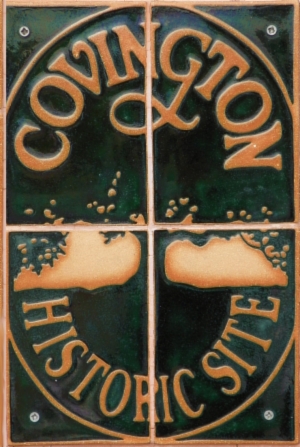 Covington has also established itself as a regional tourist destination. The city provides recreational opportunities and numerous special events that attract thousands of visitors annually. The Covington Three Rivers Art Festival is a major regional festival that attracts up to 50,000 visitors each November to view fine art and crafts displayed outdoors along six blocks of Columbia Street, from the Landing to the former City Hall in downtown. More than 200 artists from across the nation take part in this event. Covington is proud to boast that it is home to one of the state’s premier farmer’s markets. The Covington Farmer’s Market is held each Wednesday at the Covington Trailhead and Saturday on the lawn of the former City Hall. It has grown to annual gross sales of nearly $1 million. The market has become a very successful business incubator and a strong factor in the preservation of small farms in our region.
Covington has also established itself as a regional tourist destination. The city provides recreational opportunities and numerous special events that attract thousands of visitors annually. The Covington Three Rivers Art Festival is a major regional festival that attracts up to 50,000 visitors each November to view fine art and crafts displayed outdoors along six blocks of Columbia Street, from the Landing to the former City Hall in downtown. More than 200 artists from across the nation take part in this event. Covington is proud to boast that it is home to one of the state’s premier farmer’s markets. The Covington Farmer’s Market is held each Wednesday at the Covington Trailhead and Saturday on the lawn of the former City Hall. It has grown to annual gross sales of nearly $1 million. The market has become a very successful business incubator and a strong factor in the preservation of small farms in our region.
In regard to economic development coupled with cultural diversity, Covington has targeted the arts as a source of economic vitality. Several art galleries have made their homes in downtown Covington exhibiting every medium. Film and video producers are working out of downtown Covington. The film industry has seen tremendous growth in the state since the enactment of the Louisiana Motion Picture Incentive Act.
The issues surrounding annexation in St. Tammany Parish have been resolved by the execution of the Growth Management and Revenue Sharing Agreement of 2003. This agreement identifies where the City may annex property without opposition from the Parish and two areas where sales tax revenues will be shared by the City and Parish. This agreement has made planning easier by defining the City’s future growth boundaries and eliminating the guesswork on where growth will occur. It has also allowed the City to share in the revenues generated by national retailers seeking location profiles that aren’t present within the municipal boundaries.
Covington in the new millennium should be recognizable by anyone who might have been here in the old. The view may have changed a little, but its unique sense of place remains. We invite you to visit Covington to learn more about its history, culture, business opportunities and quality of life.

